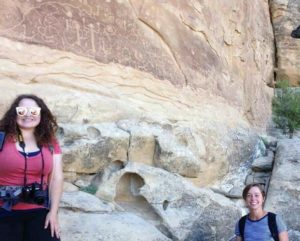
Courtesy image: Highlands anthropology students Elena Jimenez, left, and Maysie Bucklin explore Mesa Verde during a recent field school. The two are traveling to Costa Rica in December to survey an unexplored site.
LAS VEGAS, NM – A discovery of jade necklaces in Costa Rica inspired a quest by a Highlands student to find evidence of a human settlement lost to history.
Elena Jimenez, a senior majoring in anthropology, will travel to Costa Rica during the holiday break along with Maysie Bucklin, a fellow Highlands anthropology student, to find evidence of a pre-Columbian habitation along the arid Cobano region of the country.
“A year ago, my father called me and told me three pre-Columbian jade necklaces were found on my great uncle’s land in Costa Rica,” Jimenez said. “Given the depth of where they were found, I think it was associated with a burial.”
Jimenez said Costa Rica’s archeological record, while limited, is providing a glimpse of pre-Columbian life that shows evidence of more advanced, connected settlements.
One such site is the Guayabo de Turrialba settlement in central Costa Rica. Archeologists believe the settlement was inhabited from 1000 BC to AD 1400 with a peak population of around 10,000.
“It’s assumed the inhabitants of Costa Rica were hunter-gatherers, but Guayabo de Turrialba had a complex aqueduct system, water filtration systems and paved roads,” Jimenez said.
Jimenez said she believes there is evidence showing habitation on her great uncle’s land, approximately 100 miles west of Guayabo de Turrialba.
“There’s a belief that there wasn’t a lot of settlements in the area because of the drier climate,” Jimenez said. “My father said he used to find animal figurines in the area when he was a kid, and my uncle says there’s ceramics scattered everywhere.”
Jimenez said because the jade necklaces were removed from their context in the original location, she won’t be able to use the pieces for her formal survey. However, Jimenez said she believes the necklaces point to a time period between 500 BC and AD 800.
“Jade was worth more than gold for them,” Jimenez said. “and was only around for a short period of time.”
For her initial research, Jimenez said she has mapped out quadrants where she will dig small test pits every 10 meters to search for evidence of habitation. Because of Costa Rica’s strict laws surrounding the country’s archaeology, Jimenez will photograph any evidence and leave items where they were.
“Anything I find, I have to immediately report, then I will start an application to do further excavation,” Jimenez said.
Much of Jimenez’ research has involved Costa Rica’s laws impacting archeological sites.
“I’m particularly happy that she is taking what she is learning at Highlands and using it to study cultural resources in Costa Rica,” said Highlands anthropology professor Warren Lail. “One of her biggest challenges was that, although we take for granted that topographic maps are available for the entire US, there are no topographic maps for Costa Rica. To overcome this challenge, she is working with Patti Dappen in Highlands’ GIS lab to create maps of the study area.”
Jimenez said she is grateful for the support she’s received from Highlands faculty and staff from securing equipment to providing connections to archeologists familiar with Costa Rica.
“Even though Highlands doesn’t have an anthropology program focusing on Central America, I was able to do this as a senior project with the support of my professors,” Jimenez said. “I don’t think I could do anything like this as an undergraduate student at a larger college.”
Victoria Evans, Highlands anthropology lab technician, said she is excited about Jimenez’ survey.
“She has carefully researched the laws in Costa Rica and has researched the most effective way to conduct this survey,” said Victoria Evans, Highlands’ anthropology lab technician. “Not that much work has been done in Costa Rica, and I can totally see her becoming one of the top archaeologists in this area. She will make Highlands proud.
